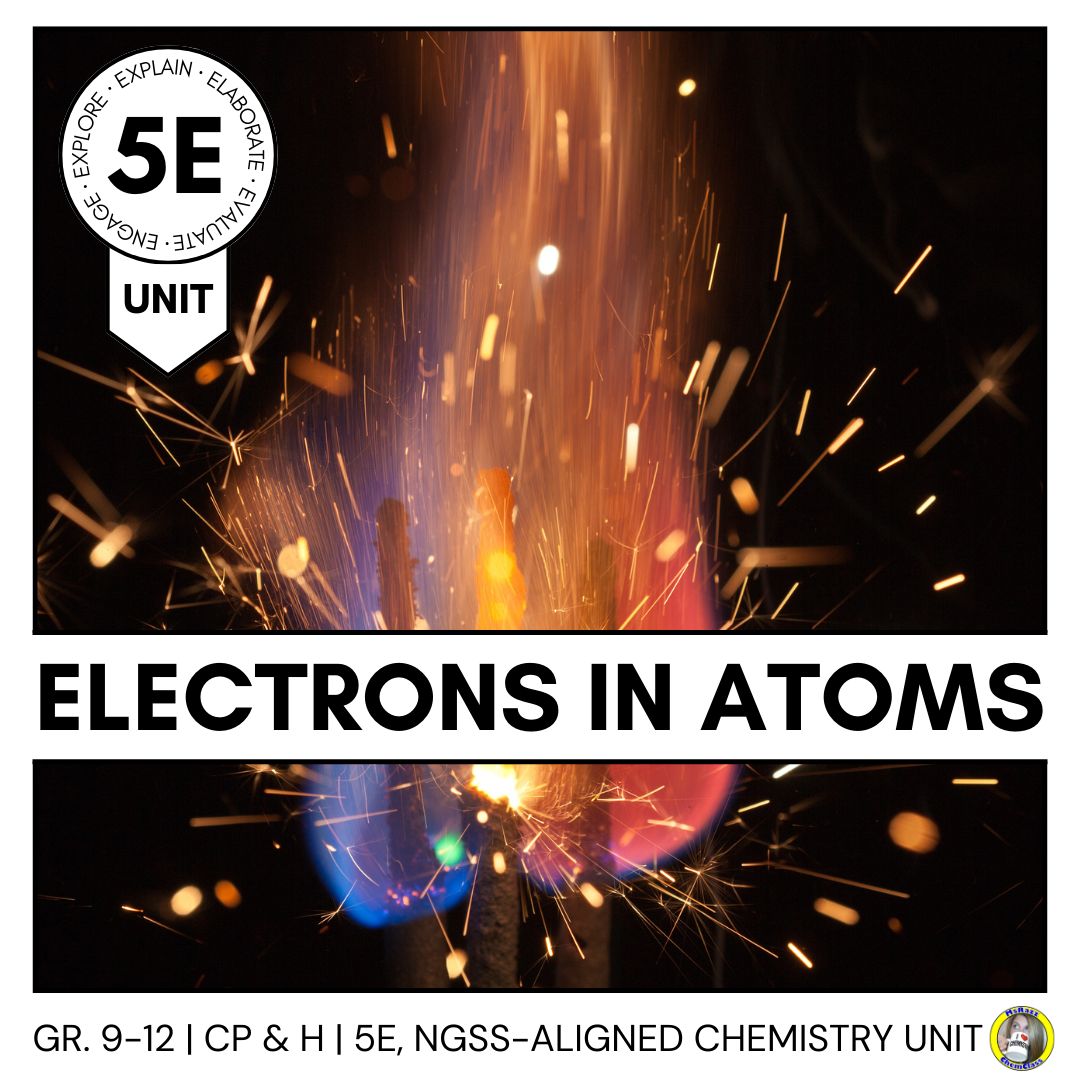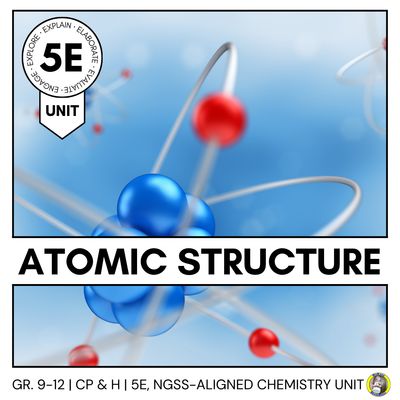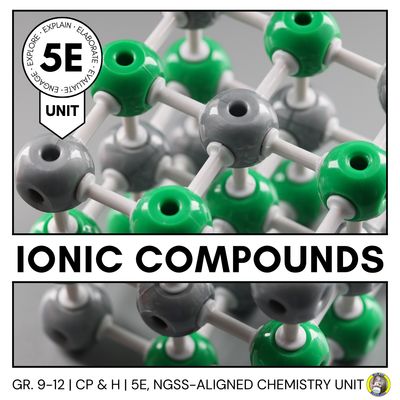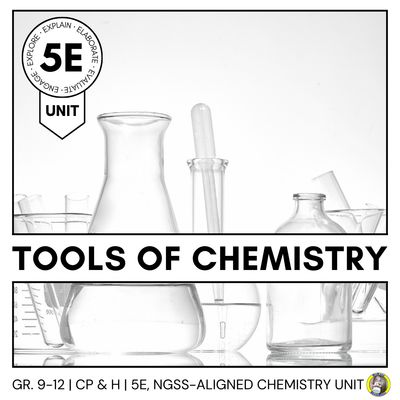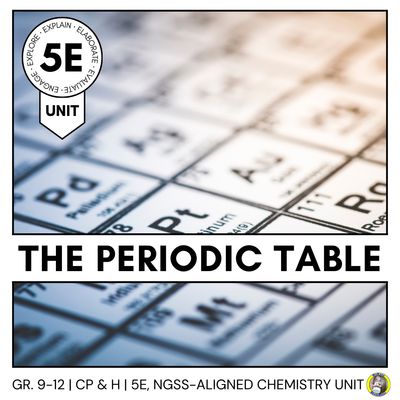ELECTRONS IN ATOMS: 5E MODEL CHEMISTRY UNIT
Watch student engagement EXPLODE in your classroom with this new 5E-aligned unit!
What is the 5E model? The 5E model was developed by the Biological Sciences Curriculum Study (BSCS) and is an inquiry-based approach to science education designed to promote active learning through five phases: Engage, Explore, Explain, Elaborate, and Evaluate. This model helps students build a deep understanding of scientific concepts by encouraging them to connect new knowledge with prior experiences and become an active participant in the learning process. In essence, your students will learn science by doing science!
Reach all learners in your classroom using this research-supported instructional approach. This unit bundle includes everything you need to inspire, motivate, differentiate, scaffold, and assess your students in learning chemistry. This technology-infused bundle is perfect for 1:1 classrooms and flipped classrooms.
Included content:
- Bohr models
- Electron dot diagrams
- Light emission/absorption spectra
- Electromagnetic spectrum
- Properties of waves
- EMR calculations (H)
- Wave-particle duality
- Quantum Mechanical Model
- Electron configurations, orbital notations, noble gas abbreviations
Standards addressed:
Performance Expectations: HS-PS1-1. Use the periodic table as a model to predict the relative properties of elements based on the patterns of electrons in the outermost energy level of atoms
HS-PS3-2. Develop and use models to illustrate that energy at the macroscopic scale can be accounted for as a combination of energy associated with the motions of particles (objects) and energy associated with the relative position of particles (objects).
HS-PS3-5. Develop and use a model of two objects interacting through electric or magnetic fields to illustrate the forces between objects and the changes in energy of the objects due to the interaction.
HS-PS4-3. Evaluate the claims, evidence, and reasoning behind the idea that electromagnetic radiation can be described either by a wave model or a particle model, and that for some situations one model is more useful than the other.
Disciplinary Core Ideas: PS1.A: Structure and Properties of Matter, PS2.B: Types of Interactions, PS4.B: Electromagnetic Radiation, PS4.A: Wave Properties, PS3.A: Definitions of Energy
Specific Science and Engineering Practices and Crosscutting Concepts are identified within each lesson in the teacher lesson planner.
Pre-requisite knowledge required:
This unit is designed to be the third unit in an on-level chemistry class. Ideally, your students would have working knowledge of the scientific process, structure of the atom, and atomic theory. Ability to solve simple algebraic equations and perform dimensional analysis is also necessary (honors).
Included learning modalities and assessments:
- (1) Phenomodeling™ Activity
- (4) Guided-Inquiry Activities
- (1) Lab Activity
- (6) Learning Station Activities
- Foldable
- PowerPoint Slides {Editable}
- Task Cards
- Formative Assessments: Google Forms™, Exit Tickets, Practice, Review Game, Video Questions {Editable}
- Summative Assessments: Unit Tests {Editable}
- Post-lab quiz
- Answer keys and grading suggestions for all activities and assessments
- Teacher Lesson Planner: Pacing, Learning Objectives, NGSS-alignment, Teacher Tips/Prep, Assessments
- Includes differentiated lessons and assessments for both college-prep and honors level chemistry.
- Free updates forever!
- Google™ Daily Agenda Slides for easier planning! (Just updated, November 2024)
Unit Duration: This unit takes approximately 2.5-3 weeks of instructional time for a traditional bell schedule. (Approximately 12-15, 50-minute periods or 7.5-8, 90-minute class periods. )
File Types: When you purchase this product, you will have access a zipped folder that contains various file types including: PDFs, Word, and PowerPoint files. External links to online resources are provided in the Teacher Lesson Planner.
Have questions? Email msrazzchemclass@gmail.com for assistance.
Enjoy!
MsRazz ChemClass
FAQs:
1. Will this resource be included as part of a larger bundle? The short answer is: Yes! Like you, I am a full-time classroom chemistry teacher, so while the process of creating and uploading resources may be slower during the school year, I have projected the following timeline (barring any emergencies) for release of each bundle:
-
Ionic Compounds, October 2024
-
Covalent Compounds, November 2024
-
Intermolecular Forces, November 2024
-
Chemical Reactions, December 2024
-
The Mole, January 2025
-
Stoichiometry, January 2025
-
Solutions, February 2024
-
Thermochemistry, March 2025
-
Reaction Rates, April 2025
- Equilibrium, May 2025
I am happy to submit a refund request for any purchases of the smaller bundles once you purchase the larger one. Just send me an email with your order number, and I will take care of the rest. msrazzchemclass@gmail.com
Store Navigation
Each purchase is for one teacher license. If multiple teachers will be using this product, please add additional licenses to your cart.
Product Terms of Use
You may:
-
Distribute and use these resources in your classroom
-
Post this product to a password protected website
-
Distribute to all students enrolled in your class
You may not:
-
Post any part of this product on the world wide web for anyone to access
-
Copy any portion of these resources and post on the web or social media
-
Share with other teachers that your licenses have not been purchased for
Return Policy
All purchases of digital resources are non-refundable. Please be sure to verify that you have the digital applications (i.e. Microsoft, Google Apps, etc.) needed to open the documents before purchasing. Please read the description and email me with any questions.

